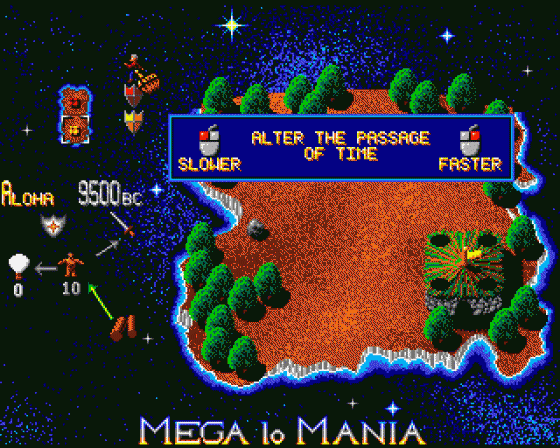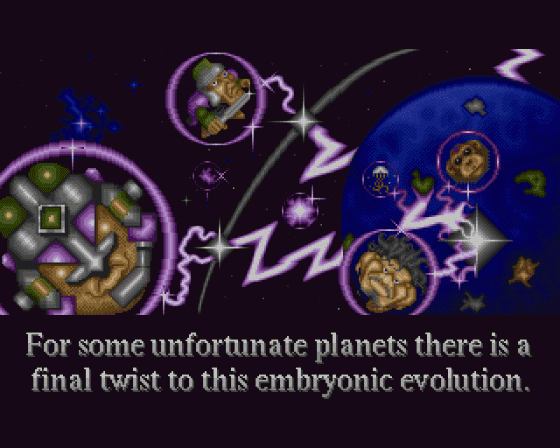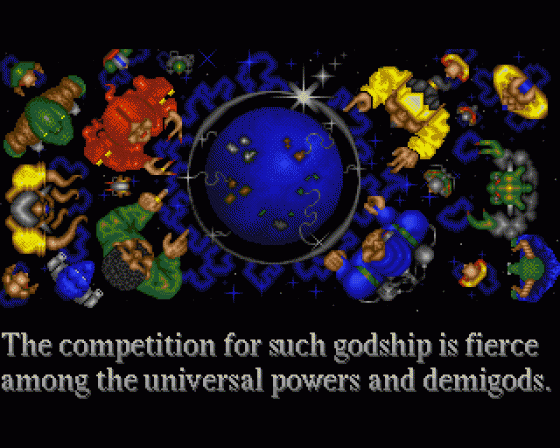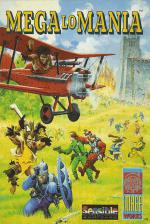
Amiga Power
 1st September 1991
1st September 1991
Categories: Review: Software
Author: Mark Ramshaw
Publisher: Image Works
Machine: Amiga 500
Published in Amiga Power #5
Mega Lo Mania
From Image Works comes the ultimate power fiend's fantasy - a light-hearted and supremely addictive strategy game which laughs when things go wrong, and manages to make Populous look very po-faced indeed
Oh no. How the hell do I even begin to explain this one? It's not that Mega Lo Mania is incredibly complex to play. Quite the opposite. For a game which relies so heavily on icons, it's remarkably easy to pick up. It's just that actually trying to explain the thing to somebody who doesn't have the game in front of them creates a few problems.
Yes, the look is vaguely Populous-y, so you know roughly what ball park we're in, but it would perhaps be more accurate to describe it as a vastly enhanced Kingdom game. For those who don't know Kingdom, it was an ancient numbers-based management thing that appeared on mainframes, Commodore Pets, BBC and the like - you simply had to juggle with your population, sending some off to tend the crops, some to defend the town, some to reproduce and so on, hopefully building a healthy community as you did so. Limited graphics appeared on some version, but they were very basic - not at all like Mega Lo Mania's cute pseudo-3D landscapes! - meaning it looked very different to this new Image Works game, though at heart the two are really very similar. Don't let the idea of Mega Lo Mania as a management game put you off though - I've never had so much fun mucking around with icons and juggling numbers in my life.
More Power To The People

So what do you actually have to do? Well, playing against up to three computer opponents, the aim is to simply conquer an island. Having selected one to try for and the number of little computer people to place there, the first step is for both human and computer characters to stake out a sector of the island. The location chosen (if the island is actually large enough to offer a choice) will actually have some bearing on later events, so a bit of experimentation is recommended. A wooden fortress is then placed in your sector, and the game commences.
The first step is to set a large numbr of people aisde to invent something. Inventions can fall into three categories. Shield strengthening (to re-build defences when your fortress and other constructions are under attack), defensive weapons (from sticks to bows and arrows to boiling pots of oil and so on), and offensive weapons for use when sending your men out on a raid (swords, spears, catapults, cannons, etc).
Each invention will take a certain amount of time to develop. This will depend on the number of people set to the task, and the complexity of the invention. Putting almost all of the population into inventing is a goodidea in the beginning. Any people left without work will stay indoors, doing what little computer people do (i.e. creatuing more little computer people). Building strength through numbers is an essential strategy, particularly if inventions and raw materials are in short supply. It's sometimes possible to storm a massive fortress with a very primitive army, and still be victorious.

Once something has been invented, you'll be able to view a blueprint of it, see what raw materials are needed (these all have corny pseudo-mineral names like planetarium, araldite, moron, and some which are just too awful to mention), then set people to the task of mining the correct quantities in order to get the inventions built. The better the balance in ore production, the quicker things are built. It's all very clever, but very easy to get the hang of.
As time progresses, chances are your guys will advance a 'tech level'. This will usually result in some niftier-looking (and tougher) buildings, and the chance to invent better stuff - even to the extent that you may find yourself building factories and laboratories to do it in. Factories let you do production runs of items, while laboratories spur on the frequency and complexity of inventions. Mines can also sometimes be set up, which result in the discovery of new raw materials. This is essential because there's only a finite quantity of each raw material in a sector. Once they've all been exhausted, it may be a case of packing your bags and colonising a new sector, if there are many unoccupied ones. (Nobody ever said taking over the world was easy!)
As you progress through the epochs, the years march on. When you get beyond the initial battles, spanning 9500BC to 1000AD, you'll find yourself in control of bi-planes and the like before eventually nuclear weapons rear their ugly heads. The game is at its funniest when you get to pit the weapons of 1945 against a bunch of Dark Age thugs - brutal and bloody it may be, but bloody good fun all the same.

Of course no way would be complete without alliances. The computer opponents are, as ever, quite shrewd about this, and will only join forces with you if it's to their advantage. Then, just when things are going swimmingly they'll stab you in the back (sometimes even joining up with other leaders against you!).
And that's pretty much the game in a (very small) nutshell. As a games concept it's just right - big enough to endow it with lasting appeal, but not so sprawling that it loses direction.
Hey, It Isn't Easy Being A God
So you think it all sounds a bit similar to Populous and Powermonger, eh? Well, you can forget that straight away. Whereas those games let you 'influence' events (not something I could ever really connect with). Mega Lo Mania plays things very directly.

You can tell every last one of your minions just what to do. This makes things a whole lot more involving on an immediate level, though admittedly losing something of the epic feel and so ultimately some of the scope.
Don't get me wrong though - this isn't an out-and-out action game. Indeed, the visual aspect of Mega Lo Mania can be quite deceptive. Although there is always something happening on-screen, you never have any action-by-action control over it, as you would in an arcade game. Your little army of men scurry around of their own accord, shooting randomly. And when you've advanced far enough to develop planes and the like, they simply glide over the screen - a bit silly, but any extra control would probably have complicated the game too much.
All in all, aside from directing your guys to adjacent sectors, or back into the stronghold, wars are pretty much automated affairs. Having said that though battles are never dull - after all, you control the deployment of wall-strengthening shields, send soldiers into the fray and place them on the battlements in real time (which is why having the clock on the slowest setting is a must) and so on, which proves to be enough for the best of us to cope with.

While at first glance the icon controls over on the left of the screen may seem a little daunting, they are actually quite easy to get the hang of. When I first played the game, I did so without even looking at the manual, and was up and running in the space of ten minutes without any trouble. Sensible Software have, quite sensibly (ahem) included a handy little explanation window which describes the function each icon performs, though (equally sensibly) it can be disabled whenever you so desire. What thoughtful chaps.
The key to the game's simplicity lies in the context-sensitive nature of these icons. At any point in time, only relevant icons can be accessed. As the game progresses, more and more icons become available (mining elements, factory building, setting up production runs and the like), but his gradual development of available commands, just the like the increasing complexity of the game, grows with the player's experience. It makes for a perfect learning curve, not unlike Activision's Deuferos.
It's Simply A State Of Mind
The urge to complete a trio of islands and advance to the next epoch really is quite tremendous. And with the ever advancing technology, there's always something new just round the next corner.

Occasionally you get to feeling the game isn't quite perfect, that the balance between total obsession and complete frustration is just about to veer sharply away towards the latter, but no. It's never quite enough to put you off the game - you'll always come back, because you just know that next epoch is almost within your grasp.
Games with little computer people running around in them can occasionally feel too slow, but happily that's not the case either. Clock fast-forward is included, thankfully - events would be alternatively too slow, then too fast, without it. I initially found myself having problems when the speed was at max, and a bunch of guys started attacking me, but after a brief chat with Sensible, they've amended the options menu to include an auto-speed option. This has the effect of slowing the game to normal speed if any enemies move into one of your sectors,giving you more time to react. This seemingly insignificant feature really elevates the user-friendliness of the program to an almost-perfect level.
Longevity-wise, the game has no problem either. With nine epochs (each with three islands) to battle through, Mega Lo Mania should certainly hold its own in the long term challenge stakes. The use of a code for each epoch is definitely appreciated too (I may have been forced to smash and burn one of the office Amigas otherwise).

One thing I haven't mentioned yet (indeed one of the best aspects of the game) is the speech. This is one of those games that gets everybody who comes within ear-shot peeking at the monitor, just to see what's making all the noise. Virtually every event in the game is accompanied by a sample. From the cockney girl informing you that, 'The production run is completed', to the Italian opponent who, upon forming an alliance with you says, "Ce, ce, why not?", it's sonic heaven. And the guy of questionable sexual orientation who says, "Do you want to be in my gang?" is a real scream. Apparently, 'real' actors were employed to provide all the samples, and it's proved to be an inspired decision.
In fact, the importance of the speech can't be stressed enough. The slickness of the presentation is what elevates this program from the merely very good to the downright brilliant. Previously speech samples on the Amiga have always come across as slightly amateurish. With Mega Lo Mania, Sensible Software have managed to pull strategy games out of the train-spotter age, and into the world of console-like mass appeal - it makes the game seem just, well, 'professional' in the same sort of way that Lucasfilm products, and very few others, are. Other programmers should take not. This is what we want - good ideas and professional presentation. Games buyers have put up with shoddy products for far too long.
Gripes, Complaints And Whinges
They're all a bit on the trivial side actually. The main one is that the graphics and animations never quite match the quality set by the sound. Armies move from sector to sector in a puff of smoke which is cute, but it might have been nicer to see them march on and off the screen one by one.

And the way the planes simply glide from the bottom to the top of the screen, then re-appear at the bottom again, is a bit tacky.
The only other program I have is with the slightly bitty backgrounds, which reminds me of Codemasters' BMX Simulator, strangely enough. A more thoughtful use of colour wouldn't have gone amiss. These really are minor points though, and the fact that these are my only complaints only serves to highlight the near perfection of the game. In fact, if I were to say that Mega Lo Mania is the only game to come between me and my beloved copy of Llamatron this month, then you've got a pretty good idea just how much I like it.
In fact, the only problem I've got with Mega Lo Mania is in trying to give it a final mark. You see, I don't enjoy playing it as much as, say, Monkey Island (yes, it's that darned game again) - its simply too frustrating at times - but it has taken over my life. It's the most compulsive computer game I've played since I was just a nipper. I guess what I'm trying to say is, it's really rather jolly good.
Mega Lo Mania has to be congratulated for being the most accessible strategy game yet. Even if you've only ever had eyes for arcade blasts or cute games like Lemmings, once you've played this for fifteen minutes you'll be hooked. Then your life will really start to fall apart.
The Bottom Line
Uppers: The best use of sound yet in an Amiga game helps catapult the presentation level into the realms of console-like ultra-slickness. Addiction in drug-like proportions. That ol' urge for 'just one more go...' has never been so strong. One meg owners get the bonus of less disk access for speech too!
Downers: The icons just very, very occasioonally get in the way a bit, and the graphics could maybe have been tweaked a bit more (collapsing buildings and dead bodies would have been fun!).
You've never had it so good. Another game to add to that list of all-time greats. Despite the premise of the game, this is one sure to appeal to all. (And how did they get that sample of Prince Charles crying, "It's all over"?)
Other Reviews Of Mega Lo Mania For The Amiga 500
The Amiga Power All-Time Top 100 '92 Part 10
Special Souvenir Supplement
Mega Lo Mania (Image Works)
A review













